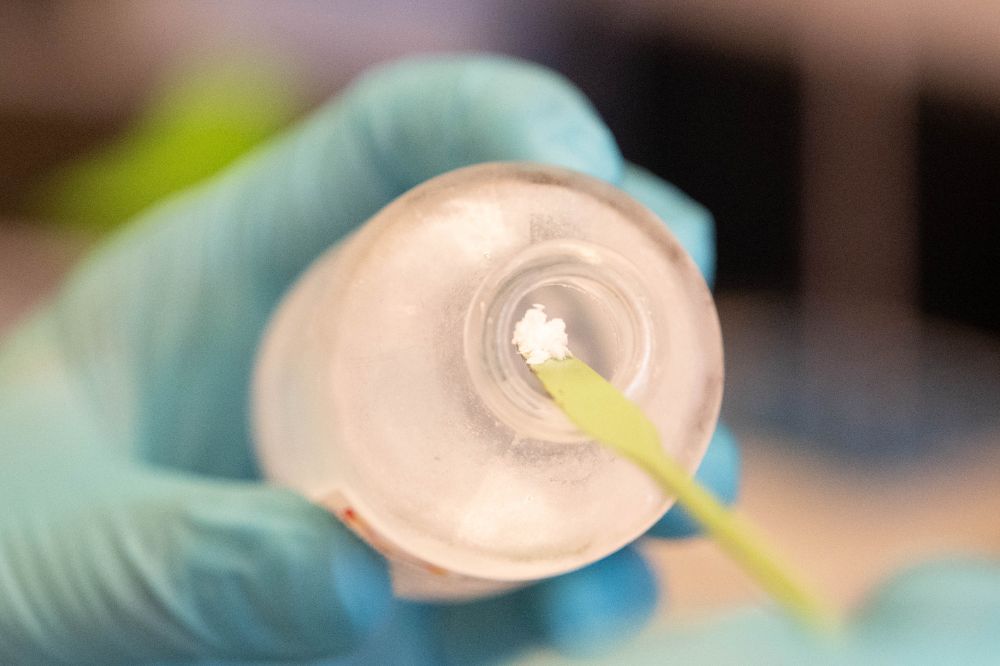
The study used purified human fibrinogen pictured here. (Credit: Lori Chertoff/The Rockefeller University)
Scientists have long known that the Alzheimer's brain often features abnormal plaques and tangles, and recent studies have highlighted the role that the brain's vascular system plays in disease progression. But for decades, this knowledge has failed to translate into fully effective treatments. The lack of progress is largely due to the fact that, despite landmark findings, the precise pathway of neurodegeneration is still unclear.
Now, new research demonstrates that when Aβ binds to fibrinogen-a major blood protein-it forms abnormal clots that are resistant to degradation. These clots are linked to vascular damage and inflammation, and even small amounts of this complex appear to trigger early Alzheimer's pathologies, such as synapse loss, neuroinflammation, and blood-brain barrier disruption. The findings strengthen the evidence that vascular disease contributes to neurodegeneration and provide hope for AD patients in the form of a promising new drug target: Aβ/fibrinogen complexes.
"It takes a larger amount of Aβ or fibrinogen alone to cause serious damage in the Alzheimer's brain," says Erin Norris, research associate professor in the laboratory of Sidney Strickland at Rockefeller. "But when the two complex together, you only need very small amounts of each to cause damage. There's a synergistic effect with Aβ and fibrinogen."
Compounding the problem
Strickland's Patricia and John Rosenwald Laboratory of Neurobiology and Genetics has been chasing the Aβ/fibrinogen complex for nearly two decades. Prior work from the lab demonstrated that Aβ binds fibrinogen and linked the complex to Alzheimer's pathogenesis. Their results suggested a connection between neurodegeneration and vascular health-a once controversial claim that has gained traction since the lab proposed it years ago. "Only recently, with a number of breakthroughs in the field, did people begin to believe that the vascular system is involved in AD pathogenesis," Norris says. "Since our initial findings, we've been focused on studying the mechanisms that explain how a dysfunctional vascular system impacts AD."
Identifying the Aβ/fibrinogen complex was a good start. But the scale of its impact-and whether the complex alone could drive Alzheimer's-remained unclear. So Strickland's team set out to form the complex at low concentrations in the lab and introduce it directly onto slices of mouse brain tissue and into live mouse brains. Their goal was to isolate the effects of Aβ/fibrinogen in detail.
"We wanted to really show the damage-to zoom in on exactly how pre- and post-synaptic terminals were being harmed," says Research Associate Elisa Nicoloso Simões-Pires.
What they found was that, while each component on its own, even in increasing amounts, did not cause much damage, the combination of low levels of Aβ/fibrinogen proved toxic to synapses and caused many of the hallmarks of Alzheimer's disease, such as neuroinflammation and disruption of the blood-brain barrier. They confirmed the complex was to blame using antibodies that blocked Aβ from binding to fibrinogen, reducing the harmful effects.
"We showed that the complex actually induces blood-brain barrier leakage, when the proteins alone did not," Simões-Pires says. "Disruption of the blood-brain barrier allows for blood proteins to cross into the brain, which lead to additional harm."
A new drug target
One of the strengths of the study was that it involved both brain slices and live mice. "It was an in vitro and in vivo project, both providing the same outcome," Norris says. "We are much more confident in our results when we can show the same thing in culture and in a living organism." Next, the team plans to explore the mechanism-why does this complex cause so much trouble?
There may also be clinical implications, because the study suggests that even small amounts of the Aβ/fibrinogen complex can trigger the features of Alzheimer's disease long before cognitive symptoms appear. Mice exposed to the complex, for instance, also showed elevated levels of phospho-tau181, a biomarker used in humans to detect Alzheimer's years before symptoms arise. This result raises the possibility that the current study is mimicking the earliest stages of AD progression and that early intervention targeting the complex itself could delay or prevent it.
While many mechanisms contribute to Alzheimer's, the team believes this particular pathway deserves more attention. "It's not a simple disease," Simões-Pires says. "A lot of other factors can induce neurotoxicity, and we certainly do not propose that inhibiting this complex formation would cure AD. But perhaps targeting this complex would alleviate some of the pathologies and be even more effective in combination with other therapies."






